THE FARMS LINES OF BROOKLYN (1874)
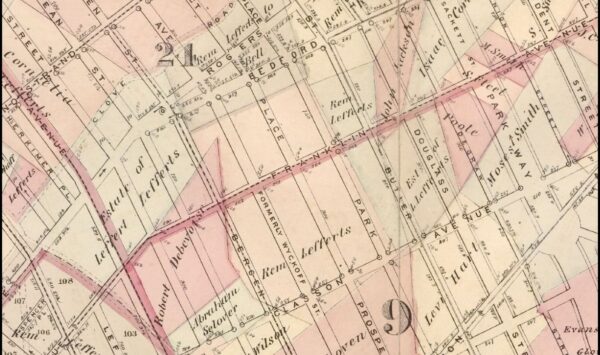
******************************************************************************************************************************** Brownstone Detectives investigates the history of our clients’ homes. The story you are about to read was composed from research conducted in the course of one of those investigations. Do you know the history of YOUR house? ******************************************************************************************************************************** Brooklyn was once one giant farm. At some point, as the farms began to be split up to be sold to developers – those who wanted to build rows of prized brownstones – companies also began to pop up which developed maps showing what types of buildings existed on every “lot” within the city. Although no longer used for fire insurance purposes, they are great tools for those owners wishing to research the histories of their properties. If you own a home in New York City, these maps can help you to determine how old it is, what else had been built in the area when your house was new, and, on some maps, the name of the farmer that had once owned your land. Find yours HERE. Follow @BrownstoneDetec Share ———————————————————————————————————————– The Brownstone Detectives Brownstone Detectives is an historic property research agency. Our mission is to document and save the histories of our clients’ homes. From our research, we produce our celebrated House History Books and House History Reports. Contact us today to begin discovering the history of your home.
THE LOST ART OF MOVING HOUSES (1900)
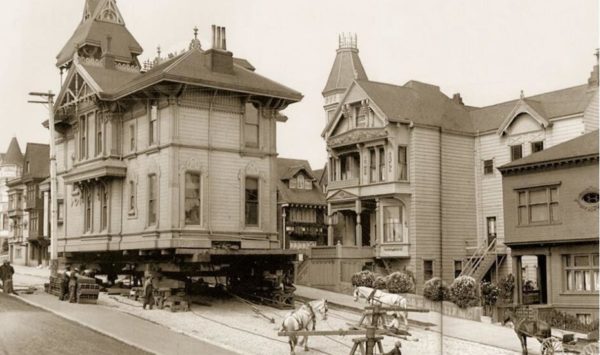
******************************************************************************************************************************** Brownstone Detectives investigates the history of our clients’ homes. The story you are about to read was composed from research conducted in the course of one of those investigations. Do you know the history of YOUR house? ******************************************************************************************************************************** An article in the 28 March 1900 edition of the Brooklyn Daily Eagle caught our eye the other day. It detailed an old practice of moving houses, and it took place in a time when the economics were such that their transport to another lot made more fiscal sense than tearing them down wholesale. In this story, however, the time it took to move this particular house took a toll on the neighboring residents. And, at one point, they gathered to tear the house down, themselves… THE HOUSE IN THE STREET The story took place in the early part of 1900 in Flatbush at the corner of Flatbush Avenue and Linden Boulevard. The subject was a frame structure that was being moved from that corner, although not quickly enough for local residents who protested the house’s temporary location on Linden Boulevard. And by “on Linden Boulevard,” we mean on the actual roadway itself. “A frame building stands in the middle of Linden boulevard, at its junction with Flatbush avenue. The building bears the sign of Vanderveer & Williamson, real estate agents,” the reporter started his story. Vanderveer & Williamson, we discovered – through combing the newspaper’s archives – were Adrian Vanderveer and Adrian N. Williamson, who had, by this point, had […]
THE SLOW MUTATION OF “THE REGINA” (1902)
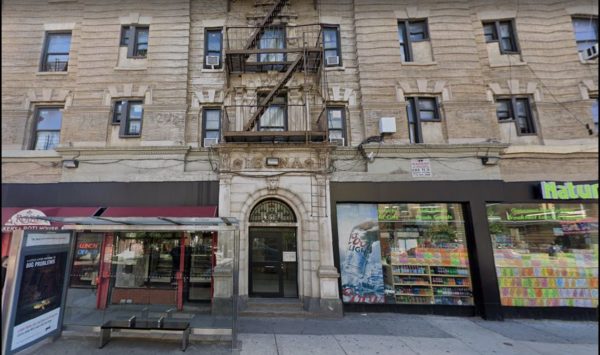
******************************************************************************************************************************** Brownstone Detectives investigates the history of our clients’ homes. The story you are about to read was composed from research conducted in the course of one of those investigations. Do you know the history of YOUR house? ******************************************************************************************************************************** In the historical research work we do for clients, we uncover old photos of their buildings in newspapers and in other archives. It is common to see that changes have taken place with these structures over the years, but these changes are not always readily apparent. Check out the following pics of this Crown Heights apartment building. See what you notice has changed in almost 120 years. Caption: “This is a picture of the Regina, a large apartment house recently bought by John Mollenhauer, the sugar refiner. It stands on the southwest corner of Nostrand avenue and Pacific street. It was built by E. J. Maguire. The building is in the heart of the St. Marks section. The transaction was partly exchange and partly cash. The building is valued at $90,000. Mr. Mollenhauer has invested extensively in property in the St. Marks section, owning several other apartment houses built by Mr. Maguire and many fine private houses. Mr. Mollenhauer lives in the Eastern District.” Follow @BrownstoneDetec Share ———————————————————————————————————————– The Brownstone Detectives Brownstone Detectives is an historic property research agency. Our mission is to document and save the histories of our clients’ homes. From our research, we produce our celebrated House History Books and House History Reports. Contact us today to begin […]
FROM A TUDOR TO A BOX (1926)
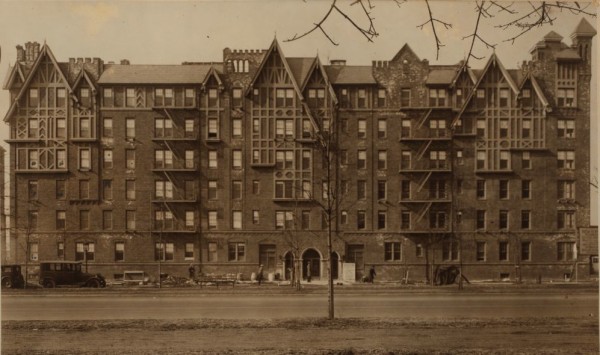
******************************************************************************************************************************** Brownstone Detectives investigates the history of our clients’ homes. The story you are about to read was composed from research conducted in the course of one of those investigations. Do you know the history of YOUR house? ******************************************************************************************************************************** It’s a given fact that we all age. It is not such a given that we all do it well. These impressive Tudor revival apartment houses were going up everywhere throughout the outer reaches of Brooklyn in the mid 1920s. The style was appealing to the Brooklynites of the Roaring ’20s, especially those who did not want the responsibility of the upkeep of a full house, had some money in their pocketbooks, and wanted a style of home that was not only visually appealing, but was also different from the stoic – and by then dated – townhouse. The “ultra modern elevator apartment house” at 1800 Ocean Parkway in Gravesend boasted an “ocean view” and apartments with cedar closets, a vapor heating system, tiled kitchens, spacious foyers, an incinerator, and selections of apartments with three, four, or five “huge” rooms each. They were renting for a princely $60 to $95 a month. No one, at the time, could have expected that these grand apartment houses would have aged so disgracefully. In this case, time has been particularly unkind. While this building may very well be structurally sound today, everything that had once made this building stand out from its neighbors – and contributed to its great “visual appeal” – has either […]
WATCHING THE (HOUSE) DETECTIVES…
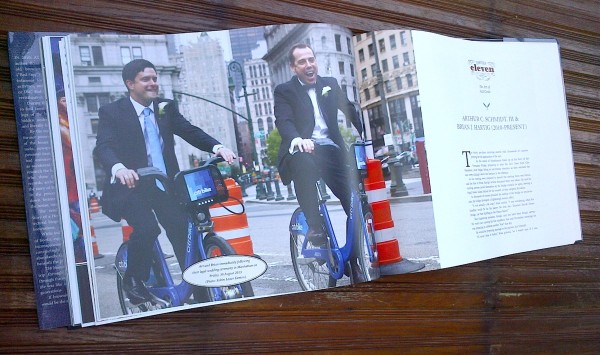
Have you ever wondered about the people who once lived in your house? Where did they sleep? How did they dress? Were they bankers, doctors, carpenters, engineers…? What were the hopes that encouraged them to go on and the secrets that kept them awake at night? Well, if you live at 738 Macon Street in the Bedford-Stuyvesant section of Brooklyn – which is a decidedly very low probability – then you are privy to the answers to these questions. And more. Brownstone Detectives, an historical investigation team, published 738 Macon Street: The Story of a House, a 170-page full color coffee table book laying out the history of the brownstone house at that address. Published in 2014, it was their first book of many others to follow. Since then, they have gone on to publish more than 50 others for homeowners in Brooklyn and Manhattan. And they plan to expand soon to the remaining boroughs and eventually to the tri-state region. Their first book – like the many that have come after it – spanned the ownership of the house for many generations, including the ownership of the land that the house was built on back to the time of the original Dutch settlers. The story is revealed in a manner that seamlessly weaves the individual owners’ stories into one continuous and flowing narrative. Rich, colorful pictures, ancestral documents, newspaper clippings, and architectural records fill the almost 200-page hardbound document. FALLING INTO HISTORY… Brian Hartig, the chief Brownstone Detective, fell […]
THE JAPANESE GILT OF 150 HANCOCK ST (1887)
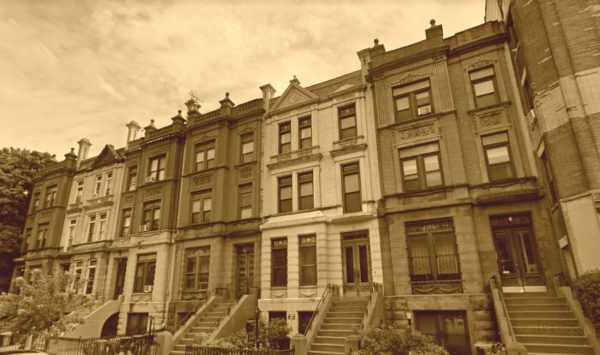
******************************************************************************************************************************** Brownstone Detectives investigates the history of our clients’ homes. The story you are about to read was composed from research conducted in the course of one of those investigations. Do you know the history of YOUR house? ******************************************************************************************************************************** Much of the design selections made by designers in the last part of the 19th century are comprised of a coterie of materials, patterns, and tools either no longer available today or much changed in their appearance. Although most builders used simple materials that did not require the knowledge or training of a master designer, some of the more high-end brownstone constructors utilized the services of those who would tailor their interiors toward the more affluent members of society. In the late 1880s, the Brooklyn Daily Eagle started a series of articles which described – in great length and detail – the interiors of individual newly-built or renovated houses. These houses were usually brownstones belonging to those affluent or upper-middle-class members of society. Not only did such articles describing the interiors of neighbors’ homes sell newspapers, but the articles also served as advertising directed at those in the market for a townhouse to have a home of their own. These advertisement-articles were placed, likely at the expense of the designers responsible for the “interior decorations” being described, as each piece ended with what readers wanted to know. “Who did the work?” THE WORK WAS DONE BY HALBERT In 1886, a row of Queen Anne style 3-story and basement “brown stone houses” […]
DESIGNING THE MAID-PROOF HOME (1922)
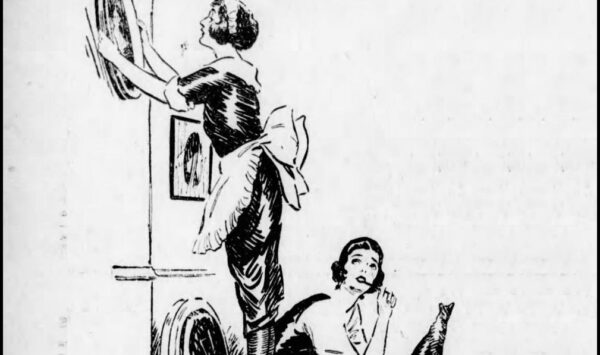
******************************************************************************************************************************** Brownstone Detectives investigates the history of our clients’ homes. The story you are about to read was composed from research conducted in the course of one of those investigations. Do you know the history of YOUR house? ******************************************************************************************************************************** We all know how difficult it is to keep a good maid. They are constantly “on the make” for higher wages or, worse, threatening to leave your employ for that of another family. But Brooklyn builders in 1922 were working strenuously to help you keep your hired help. Towards this end, they seemed to have lit well upon the solution to this dilemma: “Make a home so convenient for the lady of the house that she can do much of her own work, and, more importantly, make the maid’s room so light an airy that she’ll never want to leave.” THE MAID-PROOF LAYOUT Of course, these, presumably male, architects didn’t fail to consider the arrangement of the kitchen, where women – and maids, of course – did much of the work. Make it so arranged, said these particular architects, that it is attractive, as well as convenient. The architects, in the layout of this new model house, show a “very complete service portion with laundry on the first floor, adjoining the kitchen, instead of in the basement, as is usually the case.” Additionally, the kitchen boiler, they note, “may be placed in the basement” instead of the kitchen, where, in the past, it’s made that room “uncomfortably warm in summer.” DOWNSTAIRS. […]
A MORBID MYSTERY IN PARK SLOPE (1940)
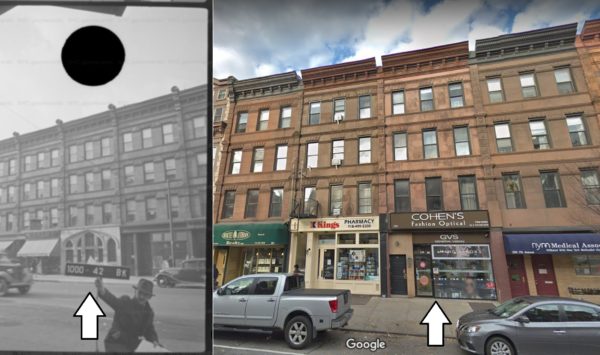
******************************************************************************************************************************** Brownstone Detectives investigates the history of our clients’ homes. The story you are about to read was composed from research conducted in the course of one of those investigations. Do you know the history of YOUR house? ******************************************************************************************************************************** When researching our clients’ properties we often come across some pretty outrageous stories, fantastic histories, and some strangely enigmatic images. During a recent review of some of the city’s tax photos featuring properties in Brooklyn from the 1940s, we came across this very interesting, yet certainly fleeting (it no longer exists), architecture constructed into a storefront on Brooklyn’s Seventh Avenue (see the left side of the photo above). It is apparent, from the rest of the neighboring storefronts, that No. 298 Seventh Avenue’s facade had been altered at some point, but to what end? The modified storefront projected a very gothic image that told passersby that something very different – and important – was going on within the building. We wondered was it a chapel, a little church, a museum? Unfortunately, the resolution of the city’s tax photos are often too grainy to make out much detail, so we had to look elsewhere for answers. We, thus, resorted to the archival images of Brooklyn newspapers to determine what had existed at No. 298 in the 1930s/1940s. When the following image popped up in our search results, all was made clear. No. 298 Seventh Avenue was a second-to-final destination for many Park Slope Brooklynites: Follow @BrownstoneDetec Share ———————————————————————————————————————– The Brownstone Detectives Brownstone […]
THE SURVIVAL OF WOOD FRAME HOUSES (1904)
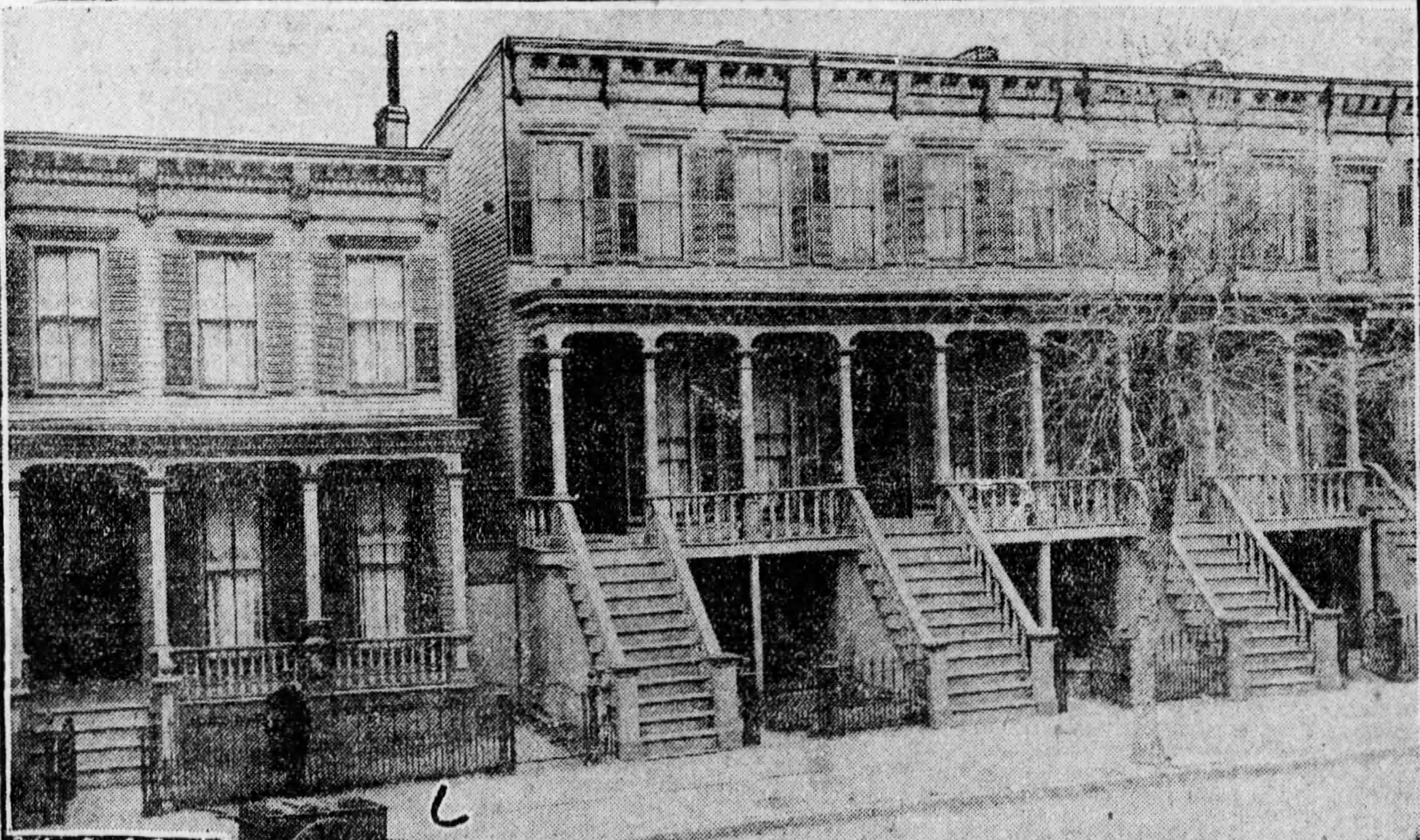
It doesn’t matter whether you view the “before” or the “after” image first. Either way, it can come as a shock how much the facade of a building can change over time. In 1904, when the houses were about 30-40 years old, the estate of Harold Dusenberry was selling four of them – Nos. 405, 407, 407A, and 409 Monroe Street. The four 3-story frame dwellings ended up being sold to an “investment company.” Comparing this picture to the current image from Google Maps below, here are five major differences we’ve noticed: 1) The house all the way to the left, No. 405, has been torn down and replaced with a “Fedders” mansion. 2) The other attached wood-frame houses, which still exist, have had their original details stripped or covered over the years. 3) Most of the cornices seem covered with vinyl siding. 4) The ornate porches have been stripped of their wood. 5) And their iron fences, though mostly present, are missing gates and sections. What other differences do you see? Follow @BrownstoneDetec Share ———————————————————————————————————————– The Brownstone Detectives Brownstone Detectives is an historic property research agency. Our mission is to document and save the histories of our clients’ homes. From our research, we produce our celebrated House History Books and House History Reports. Contact us today to begin discovering the history of your home.
BROWNSTONE DETECTIVES GETS AN ILLUSTRATOR
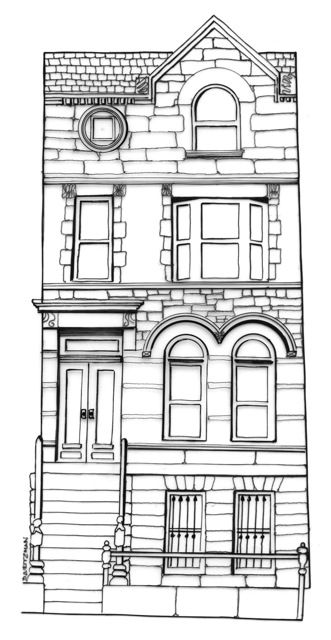
Please help us to welcome David Weitzman to Brownstone Detectives! David writes and illustrates books that evoke another time. And he has been doing so now for more than 30 years. He grew up in Chicago and as a child admittedly spent more time drawing than studying. This behavior, as if often does, landed him in art school. He received a degree from the Art Institute of Chicago in 1952, and later, perhaps to atone for his grammar-school sins, both a BS and MA in history. By the early 1970s he had moved to Covelo, California, where he began to write and illustrate children’s/young adult books about history. Around 1980 he began to specialize in historically-accurate juvenile fiction about American industrial archeology. He has written on airplanes, ships, iron foundries, metal workers, canals, windmills, bridges and subways, but has returned to the subject of steam power a number of times. David joins us to offer freehand and line drawings of our clients’ houses, many of which will grace the covers of their Brownstone Detectives House History Books! David’s first Brownstone Detectives creation is his rendering of 738 Macon Street! Maybe yours will be next! Let us know what you think! Follow @BrownstoneDetec ———————————————————————————————————————– The Brownstone Detectives This story was composed from research performed by The Brownstone Detectives. Let us do an in-depth investigation of your house and its former owners and produce your very own House History Book. Your hardbound coffee table book will include an illustrated and colorful narrative […]